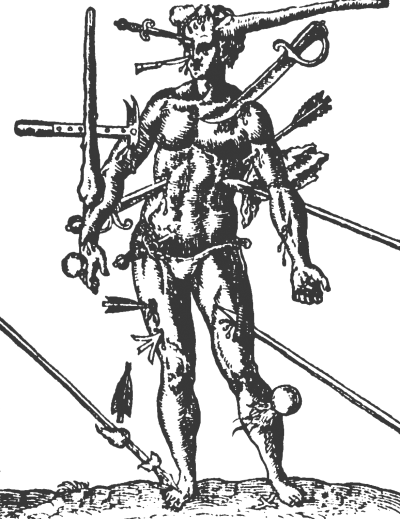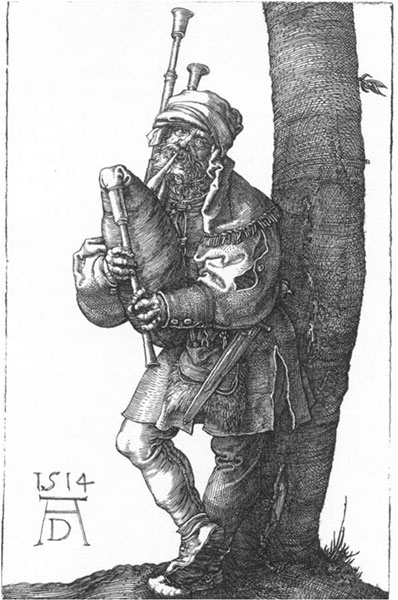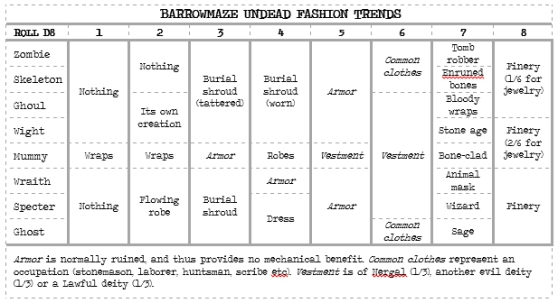The discussion about Hit Points seems to be never ending among those of us who play D&D; are they stamina, luck, injuries, skill? I’m not too worried with the discussion, actually; they are a resource which wards off death, and although that might sound dry that suffices for me as a GM. I do not, however, like all aspects of how that resource is managed. The all-or-nothing approach of most D&D versions is simple, but adds little of interest to managing wounds and risk. I’ve toyed with other versions, but so far I’ve been very hesitant because most solutions add complexity to combat, which (although fairly simple in LotFP) tends to be the most mechanical part of the game.
Then I started reading up on and planning a campaign in Pits & Perils, and the match with my concept system was suddenly far better! The lower amount of Hit Points (or simply Hits, here) makes the math work much better, at least to me. Most concepts in this system would probably work with D&D as well, though. I went ahead and included rules for being Felled (struck down to zero Hits or below); I myself don’t mind making that mean certain death, but my players are soft this way…
So, here goes; my system. This is how it has been used so far in my Pits & Perils game, which does not mean any in-depth playtesting, but my players have been very positive. Any commentary on my side is done in italics.

Hits versus Wounds
If a character rests after having lost a number of Hits, she will be able to recover from half of them. The remainder, however, are converted into Wounds. These are more long-lasting injuries, exhaustion and other ailments that will not be cured by a simple rest. For game purposes, resting a Turn (10 rounds) without interruption allows a character to remove all Hits suffered. However, half of these Hits (rounded down) are converted into Wounds. These Wounds are noted alongside Hits suffered on the character sheet, and for all intents and purposes count as damage in the same way as Hits do; they are only different in matters of recovery, as they are not affected by a simple rest.
This does add complexity, and tracking two numbers. The benefit is that any calculations are done after combat, not while combat is happening. Also, the math is pretty simple. And yes, it’s possible to “game” this system by resting only when you’ve suffered an odd number of Hits; that’s intentional, and also slightly risky.
Recovering Wounds
A character will recover 1 Wound from a full night’s uninterrupted rest. For this to be possible on the road, the camp must be well set by a competent Outdoorsman. If a character rests a full day in a bed or in similar environs (a wilderness camp will not do for these purposes), 2 Wounds can be recovered per day. These recovery rates assume that a full ration can be consumed and that water is available. A spellcaster’s HEAL spell will cure Wounds, but will always first cure any suffered Hits (thus making magical healing more effective if used in the calm after a fight, although that is not always a tactical option).
This recovery rate is fairly quick, because I like it that way, but it could be tweaked to be far worse for a realistic approach, especially if you’re not going to use the Injury rules below.
Death and dismemberment
For any but the most important NPCs or monsters, suffering damage from Hits and/or Wounds totaling more than your Total Hits means death. For PCs, and possibly key persona as determined by the GM, this need not be the case; they are simply Felled. A character which is Felled is out of the action completely for the duration of the encounter. If her companions flee or retreat, then she is at the mercy of the enemy and may or may not be revived (usually, she will instead be eaten). Otherwise, a character can be revived once the immediate danger is over, which takes one Turn. A notable exception is if the character is slain by immolation, disintegration or other similarly destructive means (at the GM’s adjudication) or if the damage was too severe (beyond 3 more than Total Hits).
When a character is revived, she must roll 2D6 on the Felled table below to determine her fate. She must deduct one from her roll for each point of damage she has suffered beyond her Total Hits (if any). If revived using magical healing, she modifies the roll with the difference between her total damage and her Total Hits after the spell has taken effect (positive or negative).
Now, these rules do add complexity, although once again only outside of combat. They can also serve to make magical healing or a Cleric even more important; whether that is a good or bad thing.
| FELLED TABLE |
| 2D6 |
RESULT |
| -5 |
Slain |
| 6-7 |
Dismemberment |
| 8 |
Grievous injury (4 IP) |
| 9 |
Severe injury (3 IP) |
| 10 |
Bad injury (2 IP) |
| 11 |
Fleshwound (1 IP) |
| 12+ |
Fine |

After revival, the character counts as having Rested as per the rules above, with half the Hits suffered converted into Wounds.
INJURY POINTS (IP) represent serious injuries; they count as Wounds and thus towards total damage. More importantly, they also give the character a negative modifier to any roll made which requires physical activity or concentration equal to one per IP, hamper movement rate på 10′ per IP (meaning armor may sometimes need to be removed) and raise the cost of any Magician spells by +1 SP per IP. Injuries resulting in IP take a very long time to heal; a character must spend at least one month in complete rest per point for them to go away. A Cleric can remedy the situation a lot faster, but a casting of the HEAL spell still only removes one single Injury Point.
DISMEMBERMENT represents permanent injury of some sort. For starters, they come with a Grievous Injury (4 IP) representing time needed to recover from them, but they also require a roll on the table below. In the case of odd injury sources (acid, fire etc) the GM will have to adapt the result below to make it fit the fiction (but the effect should remain the same). Severed legs are assumed to be replaced in some fashion, for arms/hands this is more optional.
| DISMEMBERMENT TABLE |
| 2D6 |
RESULT |
PERMANENT EFFECT |
| 2 |
Ruptured lung |
-1 to all physical activity |
| 3 |
Severed leg |
-20′ Movement, -1/-2 to certain rolls (GM’s call) |
| 4 |
Severed foot |
-10′ Movement |
| 5 |
Shattered bones |
Lose 2 Total Hits |
| 6 |
Lasting ache |
Lose 1 Total Hit |
| 7 |
Scarring |
Distinctive feature |
| 8 |
Lost fingers |
-1 to Fine Manipulation (lockpicks, stealing etc) |
| 9 |
Lost eye |
-1 to Missile Attack Dice and Searching |
| 10 |
Severed hand |
Only 1h weapons, shield still OK |
| 11 |
Severed arm |
Only 1h weapons, -1/-2 to certain rolls (GM’s call) |
| 12 |
Skull crack |
-1 to all social/mental rolls, +1 SP cost for Magician |

 My campaign isn’t as suggestive or dream-like as many others; it’s in all honesty pretty bog-standard fantasy, although the frequency of monsters (humanoids especially) is dialed down a lot, inspired by LotFP’s philosophy of keeping things strange.
My campaign isn’t as suggestive or dream-like as many others; it’s in all honesty pretty bog-standard fantasy, although the frequency of monsters (humanoids especially) is dialed down a lot, inspired by LotFP’s philosophy of keeping things strange.







